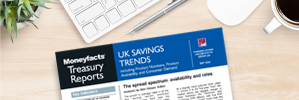Rachel Springall, Finance Expert at Moneyfacts, said:
“Savings product choice has reached a record high, and this has been largely fuelled over time by the increase of new challenger banks entering the market. New brands bring positive energy into the arena, as they typically fight harder for savers deposits to fund their future lending. However, with the Moneyfacts Average Savings Rate falling slightly to 3.50%, there is no denying that lower interest rates will dampen the sentiment of savers, but they must ensure to compare deals and switch regularly, and not to let apathy win.
“The lack of any significant moves to variable rates during July suggests perhaps a stalling approach from providers, which may well be expected. Murmurs circulated by economists for a cut to the Bank of England Base Rate, and this came to fruition earlier this month. The caution to reprice led to the average easy access rate remaining unchanged month-on-month at 2.68%, and it remains as one of the most popular types of savings account on the market. The average easy access cash ISA rate however did see a slight fall, but this space continues to see challenger banks test rate appetite, which can include hefty bonus rates. It is then perhaps inevitable to see the largest number of accounts with a bonus in more than a decade and the highest average bonus on all products on record.
“Due to concerns over falling interest rates, the popularly of fixed rate bonds might rise over the next few months. Providers have been cutting fixed rates due to fluctuations in swap rates, and anticipation for rates to head downwards in the months ahead. As a result, the average shelf-life of a fixed rate bond fell to 38 days, down from 44 days. Average rates across one-year and longer-term fixed bonds and ISAs now all sit below 4% for the first time since April 2023.
“After two months of substantial outflows in savings deposits, totalling £13.7bn for April and May this year, savers deposited £1.2bn into interest-bearing time deposits during June, according to the Bank of England. This movement was in the aftermath of a busy ISA season, where swarms of savers ploughed a record-breaking £14.3bn into cash ISAs during April, amid rumours of a cut to the tax-free allowance. It will be interesting to see whether more cash will be locked away in the coming months, particularly if savers rush to beat inflation which is expected to climb to 4% in September.”
Rachel Springall, Finance Expert at Moneyfacts, said:
“Savings product choice has reached a record high, and this has been largely fuelled over time by the increase of new challenger banks entering the market. New brands bring positive energy into the arena, as they typically fight harder for savers deposits to fund their future lending. However, with the Moneyfacts Average Savings Rate falling slightly to 3.50%, there is no denying that lower interest rates will dampen the sentiment of savers, but they must ensure to compare deals and switch regularly, and not to let apathy win.
“The lack of any significant moves to variable rates during July suggests perhaps a stalling approach from providers, which may well be expected. Murmurs circulated by economists for a cut to the Bank of England Base Rate, and this came to fruition earlier this month. The caution to reprice led to the average easy access rate remaining unchanged month-on-month at 2.68%, and it remains as one of the most popular types of savings account on the market. The average easy access cash ISA rate however did see a slight fall, but this space continues to see challenger banks test rate appetite, which can include hefty bonus rates. It is then perhaps inevitable to see the largest number of accounts with a bonus in more than a decade and the highest average bonus on all products on record.
“Due to concerns over falling interest rates, the popularly of fixed rate bonds might rise over the next few months. Providers have been cutting fixed rates due to fluctuations in swap rates, and anticipation for rates to head downwards in the months ahead. As a result, the average shelf-life of a fixed rate bond fell to 38 days, down from 44 days. Average rates across one-year and longer-term fixed bonds and ISAs now all sit below 4% for the first time since April 2023.
“After two months of substantial outflows in savings deposits, totalling £13.7bn for April and May this year, savers deposited £1.2bn into interest-bearing time deposits during June, according to the Bank of England. This movement was in the aftermath of a busy ISA season, where swarms of savers ploughed a record-breaking £14.3bn into cash ISAs during April, amid rumours of a cut to the tax-free allowance. It will be interesting to see whether more cash will be locked away in the coming months, particularly if savers rush to beat inflation which is expected to climb to 4% in September.”








